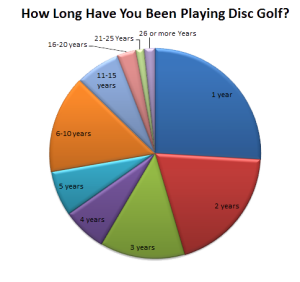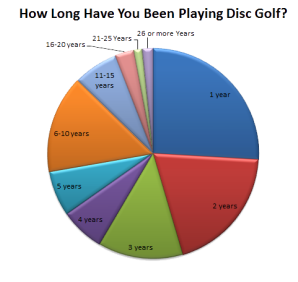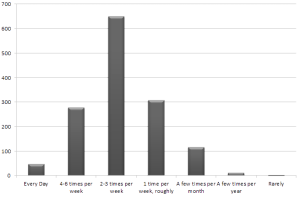The State Of Disc Golf: Membership
The State of Disc Golf 2014: Membership?
Part 2 of a seven part editorial series of the 1,422 responses from the survey “The State of Disc Golf: 2014”
We acknowledge and emphasize to you that the results here directly reflect the disc golf community who is in some way, shape, or form, involved with disc golf online. We recognize that it would be inaccurate for us to claim that this survey is a proper reflection of the entire disc golf community. The results portray disc golfers who found this survey via Facebook, Twitter, Reddit, Google+, forums, E-mail, and many other means.
Also note, charts supporting and further detailing the written data are at the bottom of the article.
Disc Golf Membership: PDGA
The PDGA (Professional Disc Golf Association) is the governing body of disc golf. For an annual fee of $30-$75 a person may become a member of the PDGA. Information on joining and benefits are found at these links. Benefits and Joining.
Of those who took this survey, 1/3 are members of the PDGA. Of the 953 respondents who said they were not currently a member of the PDGA, 41% said they intend to become a member of the PDGA, 47% were unsure, and 11% do not intend to become a member of the PDGA.
We then feel, Mr. Avery Jenkins (refer to the quote on the right), that the PDGA will likely evolve into at least 1/100th of what the PGA Tour is.
“I can only hope that Professional Disc Golf becomes 1/100th of what the PGA Tour has evolved into over the years!”
Just as a majority of players (as shown in the previous article) have been playing disc golf for a relatively short time, respondents have also been members of the PDGA for a short time. Of the 468 who said they are members of the PDGA, 80% (373) have been members for three years or less! 5% have been members of the PDGA for 10 years or more.
Disc Golf Membership: Clubs
Aside from the governing body of disc golf on a national level, there are hundreds of smaller organized groups which identify themselves as clubs, leagues, and associations. These groups are diverse as they are common (and as you travel the country, they are common). A single area may have one group or many. The group may offer incentives for joining, prizes during regularly (or irregularly) planned play and competition, and organize an ace pot and/or other cash reserves. These clubs also typically host one or several tournaments each year. Clubs may have official logos and gear such as stamped discs and clothing. Individuals most actively involved with clubs may also work closely with city planning and development towards the advancement of disc golf.
Club participation was more common than PDGA participation, with 47% of respondents stating they are a member of a club. Of those who are not currently a member of a club, only 8% have been a member before, leaving 92% (691 respondents) who have never been a member of a club. 38% of people who are not club members intend to become a member, 11% have no intention to become a member, while the other 51% are unsure.
We dug a little deeper into the statistics and we wanted to know: At what point does a disc golfer become actively involved? Is it the first year, or later once a player has gained experience? The statistics were surprising. 18% of players become involved in the PDGA in year 1, and 32% become involved with a club. By year 3, those numbers have changed drastically. In the 3rd year, 48% of players are members of the PDGA and 50% are members of a club. Unfortunately, around the 5th year, those numbers decline as though there is a “5th year disc golfer participation lull”. From there, the longest standing disc golfers club participation continues to rise, with players who have enjoyed the sport for 26 or more years being involved in a club over 62% of the time! However, PDGA membership gradually drops for the veteran players.
For those considering signing up, or for those who are running clubs, cost is always a factor in keeping clubs going.
Club Cost: Joining
One fourth of clubs have no cost to join. Then the clubs which do ask for any funds less than $10 are hard to come by, only 12% have an entry fee between $1-$10. 37% of clubs will charge anywhere between $11-$20, and 27% of clubs will charge $21 or more to become a member. Of all respondents, only 4 were not sure how much their club charges.
Club Cost: Weekly Basis
While a quarter of clubs may be free to join, chances that they’ll be free during a club round is less likely. 35% of “free to join” clubs are also free during league play while 54% will charge you at least $4 for league play. Of all clubs (not just the free to join clubs), 19% are free during regular club rounds.
Nearly one-quarter of clubs have no weekly fee and 47% are under $6. 3% of clubs will charge more than $17 on a weekly basis, those respondents may be confusing disc golf with ball golf.
Thoughts
A majority of disc golfers who took this survey (of which, many are active in the online disc golf community) have no affiliation with any organized disc golf group. This is both positive and negative. It’s fantastic because many active disc golfers enjoy the sport; courses are frequently used by a variety of people without obligation or affiliation. However, for the sport to continue its growth, an organized effort on the national and local levels needs to take place. At the same time, a majority of players without any stated current affiliation have stated intention to become affiliated with both the PDGA and local clubs, and a large percentage have stated they are unsure. The reality of today’s state of disc golf is there is growth, and there is potential.
Organizations of all levels have an opportunity to effectively reach out and offer value. If organized disc golf bodies do so the sport is poised to rise to another level of competition, professionalism, and fun.
The next article in this series will be published on February 11, and will cover Best Discs of 2013.What data would you like to see us add to the next survey to be published in 2015 regarding memberships? Feel free to let us know in the comments below!


 The first question asked was “Which state do you live in?” All fifty states in the USA were represented, as well as a strong showing from Canada and outside of North America. California is dominant with 120 responses. Does this make California the top state for disc golf? Maybe.
The first question asked was “Which state do you live in?” All fifty states in the USA were represented, as well as a strong showing from Canada and outside of North America. California is dominant with 120 responses. Does this make California the top state for disc golf? Maybe. Y
Y as varied. Over half of those surveyed have been playing disc golf for only three years or less and 87% have been play for less than ten years. This is solid evidence to the claim that disc golf is the fastest growing sport in the world. Players in the sport are new to it, and those who have played for a long time are still going strong and loving it. Given more time, and the current rate of growth, expect to see higher level competition become more lucrative, professional, and exciting.
as varied. Over half of those surveyed have been playing disc golf for only three years or less and 87% have been play for less than ten years. This is solid evidence to the claim that disc golf is the fastest growing sport in the world. Players in the sport are new to it, and those who have played for a long time are still going strong and loving it. Given more time, and the current rate of growth, expect to see higher level competition become more lucrative, professional, and exciting.
